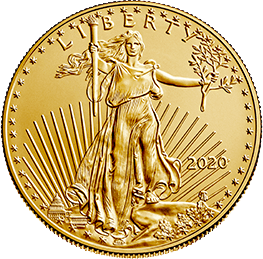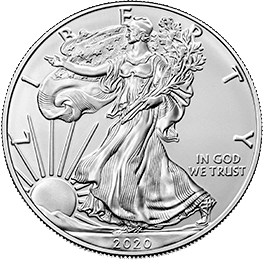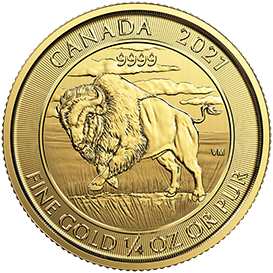
Buy Half Dollar Coins
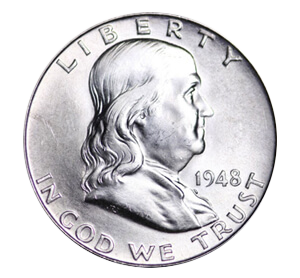
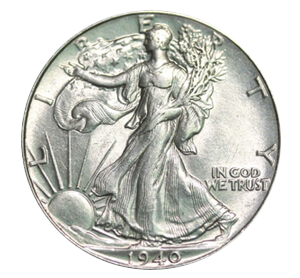



- We offer several examples of circulated silver half-dollar coins, including Walking Liberty, Kennedy and Franklin 50 cent pieces. Ask your Account Executive for more details about size and metal content on your specific interests. KENNEDY SILVER HALF DOLLAR First minted in 1964 by the U.S. Mint and designed by Gilroy Roberts, the Kennedy Silver Half Dollar coin is intended as a memorial to assassinated President John F. Kennedy and was authorized by Congress a month after his death. The original 1964 version was minted 90% silver, the 1965-70 versions were only 40% silver and the coins from 1971 contain no silver. WALKING LIBERTY SILVER HALF DOLLAR The exquisite Walking Liberty 50 cent piece is one of the most beautifully designed coins in U.S. history. Designed originally by noted sculptor Adolph A. Weinman in 1916, the model for the coin was Elsie Stevens, who also was the inspiration for the Mercury dime. Its predecessor was the Barber coinage: dimes, quarters and half dollars that had been designed by Charles E. Barber but deemed to be ready for replacement. A famous competition to design the coin was conducted by the Commission on Fine Arts, the brainchild of Mint Director Robert W. Woolley. Weinman was the winner, and the rest is history. FRANKLIN SILVER HALF DOLLAR The Ben Franklin silver half-dollar pays homage to one of the great geniuses of the 18th century: Ben Franklin. The coin was struck from 1948 through 1963 and was stopped after the assassination of JFK, so the coin is relatively rare.
Coin Details
Coin Design
- Varies: includes John F. Kennedy, Benjamin Franklin and Walking Liberty designs
Free Insured Shipping
Price Match Guarantee
Buy-Back Commitment
John F. Kennedy Half-dollar Coin
The John F. Kennedy half-dollar coin is a United States coin minted in 1964. It was issued to commemorate the 35th President of the United States, John F. Kennedy, who was assassinated in Dallas, Texas, on November 22, 1963. Here is a detailed description of the coin:
The Obverse (Front) Side:
Portrait: The Obverse features a left-profile bust of John F. Kennedy designed by Gilroy Roberts, the chief engraver of the United States Mint at the time.
Inscriptions: Surrounding Kennedy’s portrait are the words “LIBERTY” above the date of minting below. The motto “IN GOD WE TRUST” is also on the obverse.
The Reverse (Back) Side:
Design: The reverse was designed by Frank Gasparro and features a modified Presidential Seal. The eagle is portrayed with a shield on its chest, holding an olive branch in its right talon and a bundle of 13 arrows in its left, symbolizing peace and war, respectively.
Inscriptions: Above the eagle is a ring of 50 stars, representing the 50 states. Around the circumference of the coin, the words “UNITED STATES OF AMERICA” and “HALF DOLLAR” are found.
Composition:
1965-1970 Versions: The composition was changed to 40% silver and 60% copper to combat the rising cost of silver.
1971-Present Versions: From 1971 onwards, the coin’s composition has been a copper-nickel clad, with an outer layer of 75% copper and 25% nickel over a pure copper core.
1974 Version: Initially, the Kennedy half-dollar was composed of 90% silver and 10% copper, like other U.S. silver coins.
1975 and 1976 Versions: Also known as the Bicentennial Kennedy half-dollar, it is made of copper-nickel clad. This coin was minted to commemorate the United States Declaration of Independence.
Size and Weight:
Diameter: 30.6 mm (1.205 inches)
Weight: 12.5 grams (1964), 11.5 grams (1965-1970), 11.34 grams (1971-present)
Edge: Reeded
The Kennedy half-dollar has become a symbol of coinage and a coin collector’s item, especially the 90% silver 1964 version. However, its circulation has significantly decreased, leading to less common usage in everyday transactions. Some special editions and proofs have also been minted over the years for collectors.
Benjamin Franklin Half-Dollar Coin
The Benjamin Franklin half-dollar coin is another significant coin from U.S. history. It was minted from 1948 to 1963 and features the prominent American statesman, scientist, and writer Benjamin Franklin.
The Obverse (Front) Side:
Portrait: The obverse features a right-profile bust of Benjamin Franklin, designed by John R. Sinnock, the chief engraver of the U.S. Mint at the time.
Inscriptions: Surrounding Franklin’s portrait are the words “LIBERTY” above the date of the minting below. The motto “IN GOD WE TRUST” is also on the obverse.
The Reverse (Back) Side:
Design: The reverse depicts the Liberty Bell, a symbol closely associated with American independence. There is also a small heraldic eagle to the right of the bell, added to fulfill legal requirements for an eagle to be depicted on silver coins.
Inscriptions: Above the Liberty Bell, the words “UNITED STATES OF AMERICA” are inscribed, while below, the terms “HALF DOLLAR” are found. The motto “E PLURIBUS UNUM” is also marked on the reverse.
Composition:
1948-1963 Version: The Benjamin Franklin half-dollar comprised 90% silver and 10% copper throughout its production run.
Size and Weight:
Diameter: 30.6 mm (1.205 inches)
Weight: 12.5 grams
Edge: Reeded
The Benjamin Franklin half-dollar was replaced by the Kennedy half dollar in 1964, following President Kennedy’s assassination. The Franklin design was relatively short-lived, especially considering that the coin was replaced without following standard procedures to allow the design to exist for at least 25 years. This has made the Franklin half-dollar popular among collectors, particularly those in uncirculated or proof condition.
Walking Liberty Half-Dollar Coin
The Walking Liberty half-dollar is one of the most iconic coins in U.S. history. It was minted from 1916 to 1947 and is highly regarded for its beautiful design.
The Obverse (Front) Side:
Design: The obverse features a full-length figure of Lady Liberty in stride, with her right hand extended and her left holding a bundle of olive branches. She’s enveloped in the flag’s folds, with the sun rising in the background. Adolph A. Weinman created this design.
Inscriptions: The word “LIBERTY” appears above Lady Liberty, and “IN GOD WE TRUST” to the lower right. The date of minting is found on the lower left.
The Reverse (Back) Side:
Design: The reverse depicts an eagle perched on a rock with a mountain pine sapling growing from a crack. This symbolizes the USA’s ability to grow and thrive.
Inscriptions: The inscriptions “UNITED STATES OF AMERICA” and “E PLURIBUS UNUM” appear above the eagle, with “HALF DOLLAR” below.
Composition:
1916-1947 Version: The Walking Liberty half dollar was comprised of 90% silver and 10% copper throughout its production run.
Size and Weight:
Diameter: 30.6 mm (1.205 inches)
Weight: 12.5 grams
Edge: Reeded
The Walking Liberty design has been praised for its artistry and is considered one of the most beautiful designs ever used on a U.S. coin. It proved so popular that when the U.S. Mint introduced the American Silver Eagle bullion coin in 1986, they chose to revive Weinman’s Walking Liberty design for the obverse of that coin. The Walking Liberty half dollar, particularly those in well-preserved or uncirculated condition, is highly sought by coin collectors. Its beauty, symbolism, and historical significance make it a cherished part of U.S. numismatic history and a valuable coin to add to your portfolio.
Half Dollar Coins Background and History
The half-dollar coin has a rich and varied history in the United States, reflecting changing times and values in American society. Here’s an overview of the background and history of the half-dollar coin:
Early History
Flowing Hair and Draped Bust (1794-1807): The first half-dollar coins featured the Flowing Hair design (1794-1795) and then the Draped Bust design (1796-1807). These early designs were emblematic of Liberty and were typical of the neoclassical style prevalent at the time.
19th Century
Capped Bust (1807-1839): The Capped Bust design featured Liberty with a mobcap and was introduced to symbolize America’s national identity.
Seated Liberty (1839-1891): This design, which depicted Liberty seated, lasted for over half a century and saw the nation through significant changes, including the Civil War.
Barber (1892-1915): Named after its designer, Charles E. Barber, this design was more classical and less symbolic, reflecting a turn toward a modern nation.
20th Century
Walking Liberty (1916-1947): As mentioned earlier, Adolph A. Weinman’s design returned to symbolic imagery, symbolizing freedom and progress.
Franklin (1948-1963): The shift to Benjamin Franklin focused on American ideals and figures from history rather than symbolic representations.
Kennedy (1964-present): Introduced swiftly after President Kennedy’s assassination, the Kennedy half dollar was a tribute to a fallen leader and a sign of the nation’s ability to continue moving forward.
Shifts in Composition
Over time, the composition of the half-dollar changed as well. It started at 89.24% silver and 10.76% copper, then shifted to 90% silver and 10% copper. Later changes saw the silver content reduced to 40% and eliminated for circulation strikes.
Circulation and Collecting
While half dollars were once widely used, they have become less common in daily transactions, particularly since the late 20th century. Special editions, commemorative designs, and proofs have been minted over the years for collectors. The history of the half-dollar coin mirrors the evolution of the United States, reflecting changing values, historical events, and economic considerations. The half-dollar’s designs and compositions tell a rich story of American culture and history, from the symbolic representations of Liberty to the honoring of significant historical figures. Collectors continue valuing these coins for their artistic merit and historical significance.
Mint Marks
Mint marks are small letters stamped on coins to identify the mint where they were produced. These mint marks have changed over time for U.S. half-dollar coins and have been placed in various locations. Here’s a general guide to the mint marks used on U.S. half-dollar coins:
Walking Liberty (1916-1947): The mint mark can be found on the reverse side, to the left of the half-dollar denomination.
Franklin Half Dollar (1948-1963): The mint mark is above the Liberty Bell on the reverse.
Kennedy Half Dollar (1964-present): Initially, the mint mark was above the date on the obverse. Starting in 1968, it was moved to the Obverse, just below Kennedy’s portrait.
Notable Exceptions and Special Cases:
In some cases, the absence of a mint mark or the presence of a unique mint mark could indicate a special edition or error. From 1965 to 1967, mint marks were omitted from all U.S. coins to discourage collecting during a nationwide coin shortage. Mint marks are often crucial for coin collectors and numismatists, as they can significantly influence a coin’s rarity and value. Different mints may have produced varying numbers of a particular coin, leading to differences in scarcity and demand among collectors.
Half Dollar Coins Values
The current value of half-dollar coins depends on the year they were minted, their condition, and whether they are made of silver.
Half-dollar coins minted before 1965 are made of 90% silver and can be worth more depending on their condition. A coin in uncirculated condition can be worth several times its melt value.
Half-dollar coins minted from 1965 to 1970 are also made of silver, but they only contain 40% silver. These coins have a melt value and can be worth more depending on their condition. A coin in uncirculated condition can be worth several times its melt value.
Half-dollar coins minted after 1970 are not made of silver and are only worth their face value of 50 cents.
If you are coin collecting and want to acquire half-dollar coins or need more information, please visit American Hartford Gold.
Sources:
Half Dollar | U.S. Mint for Kids | U.S. Mint
Franklin Half Dollar Values and Prices | The Spruce Crafts
Walking Liberty Half Dollar Values and Prices | The Spruce Crafts
Related Products
Get Your Free 2024 Guide

Most Recent News


From Bidenomics to Kamalafare

Gold as a Safe Haven During Political Upheaval
About American Hartford Gold
American Hartford Gold (AHG) the leading Gold & Silver Specialists that helps individuals and families diversify and protect their wealth with precious metals. Through our website, publications and expert Product Specialists, American Hartford Gold offers a wealth of precious metals market perspective that empowers both new and experienced investors.
Get Your FREE Gold & Silver Information Guide

CONTACT US
Los Angeles
11755 Wilshire Blvd. 11th Floor
Los Angeles, CA 90025
Phone: 800-462-0071
Email: info@hgoldgroup.com
Woodland Hills
21550 Oxnard Street Suite 705
Woodland Hills, CA 91367
HELPFUL LINKS
The statements made on this website are opinions and past performance is no indication of future performance or returns. Precious metals, like all investments, carry risk. Gold, silver and platinum coins and bars may appreciate, depreciate or stay the same depending on a variety of factors. American Hartford Gold. cannot guarantee, and makes no representation that any metals purchased will appreciate at all or appreciate sufficiently to make customers a profit. The decision to purchase or sell precious metals, and which precious metals to purchase or sell are the customer’s decision alone, and purchases and sales should be made subject to the customer’s own research, prudence and judgement. American Hartford Gold. does not provide investment, legal, retirement planning, or tax advice. Individuals should consult with their investment, legal or tax professionals for such services.
